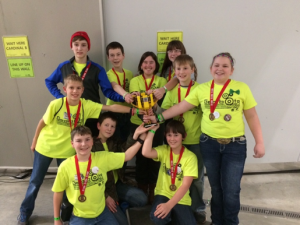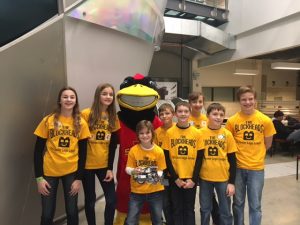
Each year, FIRST (For Inspiration & Recognition of Science & Technology) hosts the FIRST LEGO League Global Innovation Award competition funded by John Deere, Rockwell Collins and XPrize. This year twenty teams from around the globe were selected to participate in Washington, DC, on June 20. Two Iowa teams have been selected as international semi-finalists for the Global Innovation Award stemming from their participation at the Iowa FLL Championships held in the College of Engineering. The teams chosen for the international event are The Jasper County 4-H Gearbots of Newton, who have created a calf pacifier, and the TCBlockheads of Neola, who have created a TC BatClan bat house.
Camille Schroeder, Engineering Community Outreach Programs Manager and Director of Iowa FIRST LEGO League and FIRST LEGO League Junior explains the objective of the FLL program is to get youth interested in engineering. Teams not only build a fully autonomous robot to perform specific challenges, they also do research around the challenge theme including identifying a problem, coming up with an innovative solution and sharing with others. The “Animal Allies” challenge theme was designed to look at the ways humans and animals interact. Both Iowa teams did just that.
“This is a worldwide award. There are about 29,000 teams across the world, so when you put it in the context of tens of thousands of teams and boil it down to a Top 20, and you see that Iowa has two of the 20 spots, that’s a really big deal,” says Schroeder.
At the competition, the Gearbots and the TCBlockheads will engage with other teams of young, creative innovators from across the globe to share their ideas. They will meet innovation and thought leaders from all over the world, as well as present their innovation to judges to compete for the top prizes including funding, opportunities to work with experts in the field and getting patents for their innovation.
“This is our third set of teams to reach this level, which says a lot about the youth and this program in Iowa. They all have real potential to market these projects and take it a long way,” says Schroeder. “Not only are they being recognized at an international level, but it is a life changing experience to consider having a patent at such a young age. These kids are nine and fourteen years old, so it is nothing shy of amazing.”
A closer look at the team’s projects

The Gearbots have been working hard on their calf pacifier designed to solve issues related to bottle calves. Since the calves do not have mothers to feed them, cross-sucking occurs—this is when calves in the same pen suck on each other’s ears and sometimes navels. This can cause hair loss, sickness, infection, umbilical hernias and in some cases can be fatal. To help alleviate this, the Gearbots created two types of calf pacifiers—one stationary, one mobile. Both are made from sealed calf bottle nipples and are sealed to prevent indigestion, easily washable and removable by the caretaker.
The team is staying busy before the competition. “They are re-creating about 50 prototypes to distribute to interested cattlemen to test with their own livestock,” says coach, Beth Zahurones. “Each farmer will be offering us feedback on a data collection sheet that the team is compiling.”

In Neola, the TCBlockheads worked together to compile research and share their findings with professionals in the industry, friends and family. “Our team focused on bats local to our area” says the team’s coach, Shiloh Corrin. “We researched a fungus that is devastating bat populations called white-nose syndrome. This fungus disrupts bat’s natural hibernation cycles, which then lead to eventual starvation. The white fungus grows on bats noses and wings which also causes bats to grow holes in their wings making flying impossible.”
The team’s innovative solution is the BatClan house made from PVC pipes that mimics the bat’s natural habitat. “Each house has a bat monitoring camera to watch the activity at the bat houses. In addition to cameras for monitoring, the BatClan bat house has attachments for watering systems. These systems collect rain water and hold the water within the bat house to help combat dehydration associated with white-nose syndrome.”
Here is a link to the competition page.
To see more information on the College of Engineering’s Outreach programs, click here.